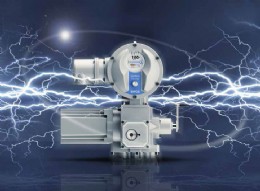View from the other side

A selection of actuators from BVAA's Valve and Actuator Users' Manual

Around 1,000 SIPOS SEVEN actuators will be supplied to the new USC coal-fired Opole power plant in South West Poland
Reach him at chris@cplloydconsulting.com
Tel 001 585 298 6239
The electric vs fluid power choice for valve actuators
Ever since the early days of valve actuator use, there has been a choice between powering the actuator with electricity or pressurized fluid. Sometimes a user industry has a traditional preference for actuator power and sometimes it’s dictated by the circumstances of the application.
Deciding the best power medium for an industrial application depends on many factors. These can be more visceral, such as following what has traditionally been used in the application. But with today’s sharp focus on return on investment and environmental impact, the traditional solutions now warrant more closer examination.
For plants that have instrument air systems the choice of actuator power has more flexibility because electric power is usually available to power the instrument air supply. So either fluid or electric powered actuators could be used. But there are many installations where an electric power supply is not available, these are usually confined to remote sites like well heads, pipeline sectioning valves or irrigation systems.
Where both power modes are available then the choice comes down to other criteria.
The traditional choice varies by industry and region.
In the earlier days of the UK power industry many power plants were controlled by instrument air controllers driving spring diaphragm and piston actuators, mainly on the smaller valves. Larger valves such as the main steam stop valves were generally electrically actuated. Modern plants use proportionally many more electric actuators, but pneumatic modulating valves are still used extensively, although they are controlled electronically rather than pneumatically.
The early designs of filter plants in the US water industry used pressurized water as a power medium for piston actuators. These have been superseded by electric actuators in the majority of newplants around the world, but there are some plants being built using pneumatic actuators for filter control.
Oil and gas production has a long history of using pneumatic actuators offshore and onshore. Probably because of the mechanical simplicity of piston operators and their straight forward maintenance. Also, an instrument air supply poses no sparking hazard to the explosive environment on an oil rig, although any solenoid control valves have to be hazardous area rated.
Some oil and gas companies are using electric actuators offshore for certain valves particularly where there are weight or space restrictions.
The functionality of a fluid powered actuator has an advantage over the electric actuator in its capacity to provide a simple mechanical fail to position function. The cylinder or diaphragm of a fluid power actuator is easily opposed by a spring that can move the valve to an open or closed position on loss of fluid power pressure.
For process shut down or safety shut down, the fluid power actuator is the traditional choice. Particularly when high levels of safety and integrity are required. There are some technologies that can provide integral backup power for electric actuators. These are becoming a viable alternative to the traditional fail to position function for process valves but are limited to smaller valves at present.
Gas pipelines often use the pressurized pipeline gas to power shut off valves for line break sectioning and general shut down. These fluid powered units often use oil as an interface between the pipeline gas and the actuator. However, many countries are restricting the use of gas powered actuators due to the environmental impact of the exhausted gas. One replacement solution is the electrohydraulic actuator which can provide shutdown capability using a spring return hydraulic actuator. For remote areas, these units can be solar powered, using a DC motor powered hydraulic pump to drive the reset stroke after a shut down.
For smaller process control valves, the traditional actuator is the pneumatic spring diaphragm unit. This is a simple but effective Around 1,000 SIPOS SEVEN actuators will be supplied to the new USC coal-fired Opole power plant in South West Poland. device with few moving parts. To make a complete automated valve it is usually coupled to a positioner, often a 'smart' device. Most process control valve makers manufacture their own diaphragm actuators and package them with the valve and positioner as a complete unit.
The relative capital cost of electric actuators when compared to fluid power units of equivalent output is usually greater. The electro-hydraulic designs are the exception as they combine components of electric and fluid power units.
The running cost of actuators does not always figure prominently in evaluations, but for frequently modulating valves this could be significant. Electric actuators look good in these scenarios as they only use energy when moving. Fluid power units using instrument air have a constant energy draw from positioner bleed and system leakage. The carbon footprint is lower for electric units.
Actuator manufacturers of both types of actuator are constantly improving their products. From the control room or maintenance shop, there is the ability to monitor and diagnose issues with actuators so that planning maintenance can be streamlined and plant downtime reduced to a minimum. The smart controls on actuators are available for fluid and electric powered actuators so the actuator power supply is transparent to the control room.
The general trend appears to be an incremental encroachment on the traditional applications for fluid powered actuated valves by electric actuators in certain niche areas. However, there is no doubt that there is a robust and diverse demand for fluid power actuators both now and into the future.

| Telephone: | 01295 221270 |
| Email: | enquiry@bvaa.org.uk |
| Website: | www.bvaa.org.uk |
| More information on the British Valve and Actuator Association BVAA Member Directory Page |
Search related valve / actuator articles: British Valve and Actuator AssociationIssue 33BVAA NewsBVAA Comment













